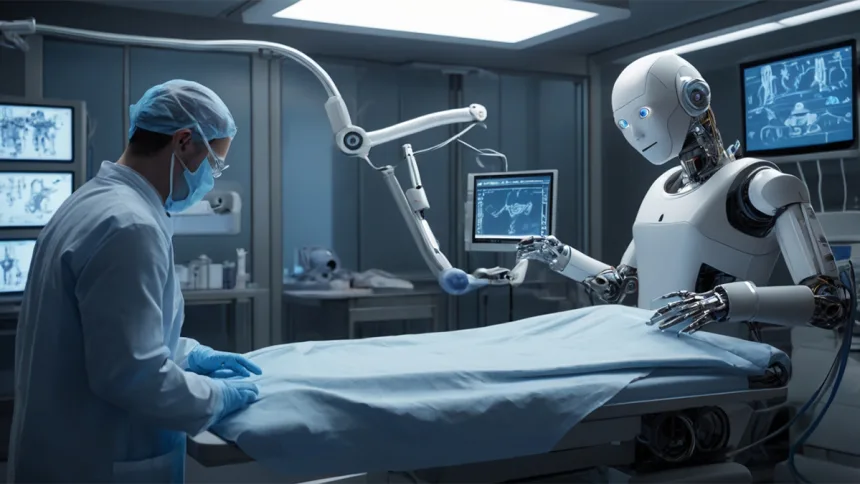Robotic surgery is changing the way surgeries are performed today. With advances in technology, these high-tech machines have become important tools for surgeons, helping to make operations safer, more precise, and less invasive. This article will explore how robotics in surgery improves precision and safety, making it a significant part of modern healthcare.
What is Robotic surgery?
Robotic surgery involves using robotic systems to assist doctors during surgery. These systems allow surgeons to perform delicate and complex procedures with more control and flexibility than traditional surgery. One well-known example is the da Vinci Surgical System, which has been widely used in hospitals around the world for different types of surgeries, such as heart surgery, prostate surgery, and gynaecological procedures.
In a robotic surgery, the surgeon doesn’t physically touch the patient. Instead, they sit at a console and use hand controls to operate the robot. The robot has arms with surgical instruments, and a camera provides a detailed, three-dimensional view of the surgical site. This setup allows for greater precision and reduces the risk of human error.
Benefits of Robotics in surgery
1. Enhanced precision
One of the key benefits of using robotics in surgery is the high level of precision it offers. Human hands, even with the best training, have natural limitations. A surgeon’s hand might shake slightly during an operation, but a robotic arm remains steady. This can be especially important in delicate surgeries, where a tiny mistake could lead to complications.
For example, in brain surgery or heart surgery, even a minor slip of the hand could have serious consequences. Robotics allow for incredibly fine movements, helping surgeons operate with millimeter-level accuracy. This precision is particularly valuable when working around delicate tissues, nerves, or blood vessels.
2. Smaller incisions
Robotic surgery typically requires smaller incisions compared to traditional open surgery. In many cases, minimally invasive procedures are possible because the robotic instruments are smaller and more flexible than human hands. Smaller incisions mean less trauma to the body, which leads to faster recovery times for patients and reduces the risk of infection.
For instance, in laparoscopic surgery, which is a type of minimally invasive surgery, robotics can enhance the surgeon’s ability to navigate through small spaces with precision. Patients often experience less pain after surgery and can return to their daily activities more quickly than they would after traditional surgery.
3. Improved safety
Safety is a top priority in any surgery. Robotic systems are designed with multiple safety features to minimize risks during operations. The technology provides surgeons with a clearer and more detailed view of the surgical site, allowing them to spot potential issues earlier.
Furthermore, many robotic systems come with built-in safety checks. For example, if the robot senses that an instrument is moving too close to a critical area, it can automatically stop or slow down to avoid causing harm. These features significantly reduce the chances of accidental injury during surgery.
Also Read: How AI is revolutionising diagnosis and treatment
4. Better access to hard-to-reach areas
In some surgeries, it’s difficult for surgeons to reach certain areas of the body with traditional tools. Robotic systems are equipped with advanced instruments that can rotate and bend in ways that human hands cannot. This flexibility allows surgeons to access difficult-to-reach areas with ease, making complex surgeries more manageable.
For example, in certain types of cancer surgeries, tumours may be located in hard-to-access parts of the body. With robotic assistance, surgeons can remove these tumours without needing to make large cuts or move other organs around, which can lead to fewer complications and faster recovery times for patients.
The field of robotic surgery is still evolving, and future advancements will likely make these systems even more effective
Moh Thudor MBA ME BSc, Director of International Strategy, Open Medical
Types of Robotic surgery
Robotic surgery can be used in many different types of procedures. Some of the most common areas where robotic systems are used include:
- Cardiothoracic Surgery: Robotic systems help surgeons perform complex heart surgeries with more precision, such as bypass operations or valve repairs.
- Urological Surgery: Robotics are commonly used in procedures like prostate removal (prostatectomy), allowing for more accurate removal of cancerous tissue while preserving important nerves.
- Gynecological Surgery: Robotic surgery is often used in procedures like hysterectomies or endometriosis treatment, helping reduce pain and recovery time for patients.
- General Surgery: Robotic assistance is also valuable in general surgeries such as gallbladder removal or hernia repair.
Challenges and limitations
While robotic surgery offers many benefits, it is not without challenges. One of the main limitations is cost. Robotic systems are expensive to buy and maintain, which can increase the overall cost of surgery for hospitals and patients. Not all healthcare facilities can afford this technology, which means that not every patient has access to robotic surgery.
Another limitation is the learning curve for surgeons. Although many surgeons are trained in robotic systems, it requires special training and practice to become proficient. However, as more surgeons become familiar with these technologies, the learning curve is expected to become less of an issue over time.
The future of Robotic surgery
The field of robotic surgery is still evolving, and future advancements will likely make these systems even more effective. Researchers are already working on developing AI-powered robots that can assist with surgery, potentially increasing the level of precision and safety even further.
For example, AI could help robotic systems recognize tissue types or predict potential complications before they happen. Such advancements could lead to a new era of surgery where robots not only assist but also make real-time decisions to improve patient outcomes.

Additionally, remote robotic surgery may become more common. With advances in communication technology, surgeons could potentially operate on patients located in different cities—or even countries—using robotic systems. This could greatly expand access to specialized surgeries for patients in remote areas or those who don’t have immediate access to highly trained surgeons. Robotics in surgery is revolutionising healthcare by offering enhanced precision, safety, and better outcomes for patients. The ability to make smaller incisions, reduce recovery times, and minimise complications is helping robotic surgery gain widespread adoption in hospitals worldwide. While there are some challenges, such as the high cost and learning curve for surgeons, the benefits far outweigh the drawbacks. With continued advancements in technology, the role of robotics in surgery is expected to grow even more, making surgeries safer and more efficient for everyone.



















